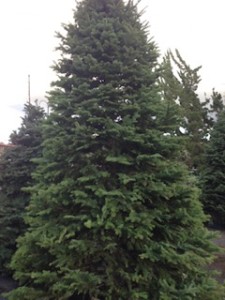Christmas trees come very close to exceeding nature. ~Andy Rooney
When my children were youngsters, cutting a tree was the big event of the season. Weâd don our Santa hats, grab a bundle of rope to tie the tree to the top of the car, put film in the camera, and off weâd go, singing Christmas carols while plotting our adventure. It could take hours walking through a farm, checking out tree after tree, debating the merits of each. Sometimes weâd visit two or three farms before finding the perfect one. Afterwards, at home with our freshly cut treasure, weâd light a fire, drink hot cocoa and eggnog, eat persimmon pudding and Italian panetone, put on the Christmas music, and dance around the house as we spruced the fir with popcorn and cranberry strings, homemade ornaments, tinsel, and of course, plenty of twinkling lights.
One day my son had the bright idea that we should grow our own Christmas trees in order to have a never-ending supply of Yuletide enchantment. With the best planting season for evergreens between January and March, as soon as the small containers of conifers went on sale for $1.00 post holiday, we nabbed twenty for our forthcoming Christmas tree farm. We chose a prime spot at the top of our hill, prepared the plot, cleared the weeds, planted the seedlings, protected them with wire from marauding munchers, maintained soil moisture, and waited. The kids were very attentive to their trees. By year three, pruning and shaping the trees into conical forms began. Who knew that âChristmas treesâ didnât automatically grow into perfect Christmas specimens? By year seven, they cut their first glorious imperfect tree and by year thirteen all of the trunks were too large for any tree holder. Instead of cutting another tree, we potted a large Norfolk pine, added it to our entrance, where this oxygen producing, carbon dioxide absorber has served as our beloved arbre de Noel.
History, legend, or a combination of the two chronicles the tales of 16th century Germans bringing evergreens into their homes as holiday decor after Protestant reformer, Martin Luther, witnessed the stars sparkling through the forest trees and cut a tree to enjoy indoors. In 2014, Christmas trees are as significant to American culture as apple pie. But it wasnât until 1848 that Puritanical America embraced the idea of the âpaganâ Christmas tree. The ever-popular Queen Victoria and her German Prince Albert were sketched with their children gathered around a decorated Christmas tree and East Coast society adopted this new fashionable trend. Currier and Ives jumped on the bucolic family festivity bandwagon by immortalizing vintage America in historic lithographs of cozy Christmas scenes including sleigh rides, crackling fires, candle lit chapels, snowmen, and tree decorating.
Yet, the love of winter evergreens was celebrated long before the arrival of Christianity. In ancient Egypt, the sun god Ra was honored on the longest night of the year,December 21, and the shortest day, December 22 with palm frond decorations to symbolize life over death. The Romans marked the solstice with evergreen boughs in anticipation of a prosperous spring. The Druids used greens as symbols of eternal life while the Vikings believed that evergreens were the chosen trees of their sun god, Balder.
With the advent of electricity, Thomas Edison presented the possibility of twinkling tree lights without as much fire danger from branch tied candles. Europeans preferred small trees of four feet, Americans sought plants that would reach the ceiling. Decorations in the early days included strands of nuts, berries, apples, and popcorn. Today, a fortune can be spent on accessories and unique ornaments fit for a king from hand carved Nativity scenes to hand blown glass angels.
When to buy, cut, and trim the tree vary from country to country. Many American families get into the December spirit immediately following Thanksgiving while many Europeans wait until Christmas Eve to launch their rituals. Evergreen garlands, boughs, ivy, mistletoe, wreaths, poinsettias, and holly join the enticing kitchen aromas of gingerbread, marzipan, and hot mulled wine making our Christmas castles merry and bright.
Grown in all fifty states, Christmas tree farming is big business, although it is mostly small farmers who do the growing, planting as many as two thousand trees per acre. Seventy seven million trees are planted annually as American consumers purchase approximately 30 million farm grown trees valued at more than $1 billion. Fresh trees (to me the only way to play) outsell artificial trees three to one. Young families who are starting their own traditions often prefer to cut-their-own at a Christmas tree farm, enjoying a day in search of the perfect tannenbaum, as our family did in years past.
As you banish the blues with the greens of a pine, fur, spruce, redwood, cedar, or cypress, youâll be rewarded with the fresh fragrance of the wild woods. Remember to keep your cut tree watered as most farmed trees are chopped down in October or early November then trucked to the retailer. While they wonât dry out outdoors, once indoors, your specimen will need a quart to a gallon of water per day depending on the size.
This year, whether your tree was grown on a plantation or in your backyard, bring the botanical brilliance of a live tree into your seasonal festivities and celebrate the magic.
O Christmas Tree, O Christmas Tree,
Your branches green delight us!
Wishing you seasonal sparkle, glow forth to enjoy being home for the holidays.
Cynthia Brianâs Mid Month Reminders
COOKÂ with either fresh or dried herbs. Youâll need more when you use fresh. Dried are more potent. For every tablespoon of fresh herbs in a recipe, substitute 1 teaspoon of dried.
CREATEÂ a stunning DIY holiday table arrangement using a combination of ornamental cabbage, lilies, evergreen branches, white roses, and pinecones.
LOOKINGÂ for a last minute gift that will be unique and useful? Check out your local garden retailers for holiday ideas, including a pot of drought resistant kalanchoe or a Christmas cactus in bloom.
TRIMÂ low hanging branches of redwoods, pines, firs, and other evergreens to use in wreaths, garlands, and holiday ornamentation.
CAREÂ for your land and your land will care of you. Our good earth is Mother Natureâs Christmas gift to us.
Happy gardening, happy growing, fa la la la la!
Cynthia Brian
Read more Lamorinda Weekly.
©2014
Cynthia Brian
The Goddess Gardener
Starstyle® Productions, llc
925-377-STAR
I am available as a speaker, designer, and consultant.
Cynthia Brian is a New York Times best selling author, speaker, coach, and host of the radio show, StarStyle®-Be the Star You Are!® broadcasting live every Wednesday from 4-5pm PT on the Voice America Network.. She also is the creator and producer of Express Yourself!⢠Teen Radio and Executive Director of Be the Star You Are!® 501c3 charity.











